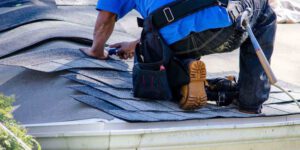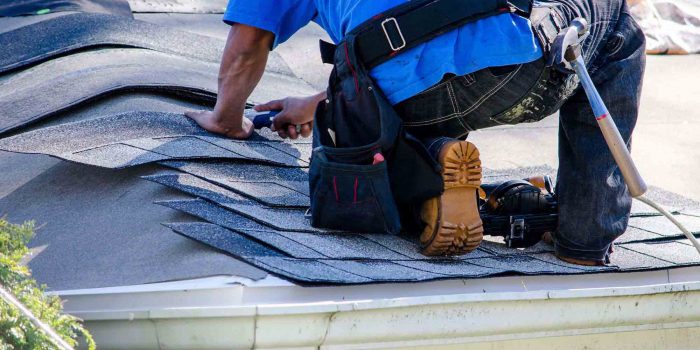Your roof protects the structure and contents of your home. Like any other part of your home, it requires regular maintenance to prevent extreme damage and major leaks.

A routine inspection by West Chester Roofing can help you catch problems before they become severe. A few small repairs can also save you money.
Flashing is sheet metal fabricated to a specific shape and placed in areas of the roof that are especially vulnerable to leakage. It is installed over and under shingles and around things that protrude from the roof, such as chimneys and vent pipes. Without properly functioning flashing, water can penetrate the roof, causing a wide range of damage to both the shingles and the framing of the house. The simplest way to check your roof flashing is to look for caulk that has cracked, peeled, or is missing altogether. This is often the first sign of a leaking roof.
Ideally, flashing should be fastened with stainless steel screws and then covered with roofing cement. Over time, it’s common for these screws to loosen and pull out. In addition, the metal can wear away from the area around each screw head, and the flashing may start to deteriorate. If this occurs, you can easily replace the flashing with new material.
The type of flashing that is most vulnerable to leaks is the type used at the joints created by different parts of the roof, such as a valley or corner. A building inspector will make sure that the flashing is installed according to the codes in your area. If not, he or she will advise you about needed repairs.
When checking the flashing, the inspector will also examine the condition of penetration seals on vent pipes, roof ridge vents, and other items that create holes in your home’s roof. These seals help keep rain and other weather from leaking into your house through the holes. The inspector will look for signs of cracking, rusting, or discoloration and will test the integrity of the seals by pulling on them.
As the inspector moves from one part of the roof to another, he or she will also look for shingle damage. Missing shingles, curled or buckling shingles, and moss growth are all signs that the roof needs to be replaced. Inspecting the gutters, chimneys, and dormers for cracks or leaks is also a good idea. The inspector will also examine the fascia boards for rot and insect damage.
Clean the gutters.
Gutter cleaning is an important part of roof maintenance that many people overlook. The location of gutters on a home often makes them out of sight and out of mind, but they are vital to the proper functioning of your roof. Without working gutters, your roof can suffer significant damage. Gutters that are clogged and filled with debris can cause rainwater to overflow and soak through the shingles, damaging them. This can result in leaks inside the home and further water damage to wood fascia boards, windows, walls, and ceilings. In addition, clogged gutters can also lead to the development of toxic mold.
Cleaning your gutters is a simple yet necessary task. Ideally, homeowners should clean their gutters at least twice per year: once in the fall and once in the spring. In the autumn, homeowners should take extra care to ensure their gutters are clean and free of debris due to the rapid change in weather conditions that occur during this time of year.
A clogged gutter can be an inviting place for insects, birds, rodents, and other critters to build nests and reproduce. This can be a real issue if you live in an area that is prone to infestations of these creatures. In addition, a clogged gutter can block the flow of rainwater from the roof to the downspout. This can lead to the soil surrounding your foundation becoming saturated, which can cause it to expand and push on the structure of your home.
When you do decide to clean your gutters, it is always best to work with a partner and use a ladder that is secure and sturdy. This will help to prevent any accidents or falls that could end up costing you money on costly repair bills. Also, be sure to wear sturdy work boots and a pair of thick gloves while you are climbing around the roof and clawing at gunk with your hands. Finally, be aware of any power lines above your house and always work below them. Taking these safety precautions can significantly cut down on the time you spend on the ladder and make the job of cleaning your gutters much easier and less dangerous.
Inspect the shingles.
The shingles of a roof protect the home from water damage and other environmental hazards. Because of this, it is important to regularly inspect the shingles on your roof. A regular inspection will allow you to identify potential problems and make repairs before they become major problems. During your inspection, look for curled or buckled shingles as well as granule loss. These issues will leave openings for water to enter the house, causing serious and expensive damage.
Missing shingles are also a concern. It only takes one missing shingle to create a leak, and the damage will get worse over time. If you notice a shingle missing, it is best to call a professional roofing company as soon as possible.
Hail and wind damage can also cause shingle damage. You will usually be able to see this damage as pockmarks on the shingles. If you have recently had hail or wind damage, it is important to call a roofing contractor to repair the roof right away.
The last thing you want to look for is moss, lichen, or algae growth on your shingles. These growths can trap moisture on your shingles, which can lead to rot and water leaks. If you find any of these growths on your roof, have a roofing professional remove them and apply preventative products to keep them from growing back.
You should also look for signs of sagging or leaks in the attic and upper floors of your home. If you do notice any water stains, mildew, or mold, these are signs that the roof needs to be repaired.
In addition to these steps, you should walk around the exterior of your home and check the gutters, fascia, soffit, and chimney for damage or rot. If you are fit enough, you can climb a ladder to visually inspect the entire roof from above. Look for any areas of the roof that need to be caulked, such as around vent pipes or the chimney flashing. Check for any rust on the metal flashing as well. Finally, you should look for any areas of the roof that need to have shingles replaced.
Inspect the flashing.
Flashing is something that often gets overlooked during roof maintenance, but it’s important. It’s the thin metal pieces that tie together different parts of your roof at seams and corners, as well as around things that protrude from the roof like chimneys and vents. It also prevents water from entering areas of your home where it could cause damage. Without proper flashing, your roof could leak in places you never imagined possible.
Roof flashing is usually made of aluminum, which has anti-corrosion properties. But it’s not indestructible, and flashing can be damaged by powerful storms or even by improper installation. A professional roofer can help you find and repair any issues with your roof flashing.
The majority of roof leaks start at the flashings, and a detailed inspection of your roof flashings can identify many of the common problems that can occur. A roof inspector will check the flashing at skylights, perimeters, walls, penetrations, equipment curbs, and drains to ensure that they are in good condition. In addition, a roof inspector will make sure that all of the flashings are installed properly in accordance with building codes.
One of the most common flashing problems is that the caulk used to seal the flashing starts to degrade and peel away. A caulk that peels is not as effective at keeping moisture out, and it can actually allow water to penetrate the flashing and cause damage to your home. Replacing the caulk on your roof flashings is an easy and inexpensive fix that can go a long way toward protecting your home.
In addition, a roof inspector can help you determine whether your roof needs to be repaired or replaced. Many roof leaks are caused by old or damaged flashing, and catching them early can save you both time and money. If you notice signs of flashing problems, it’s important to contact a professional roofer for repairs right away.
If you’re unsure about how to inspect your roof or would like to discuss the condition of your roofing system with a professional, contact us today. We can provide you with a free roof estimate and recommend any necessary maintenance or repairs.

